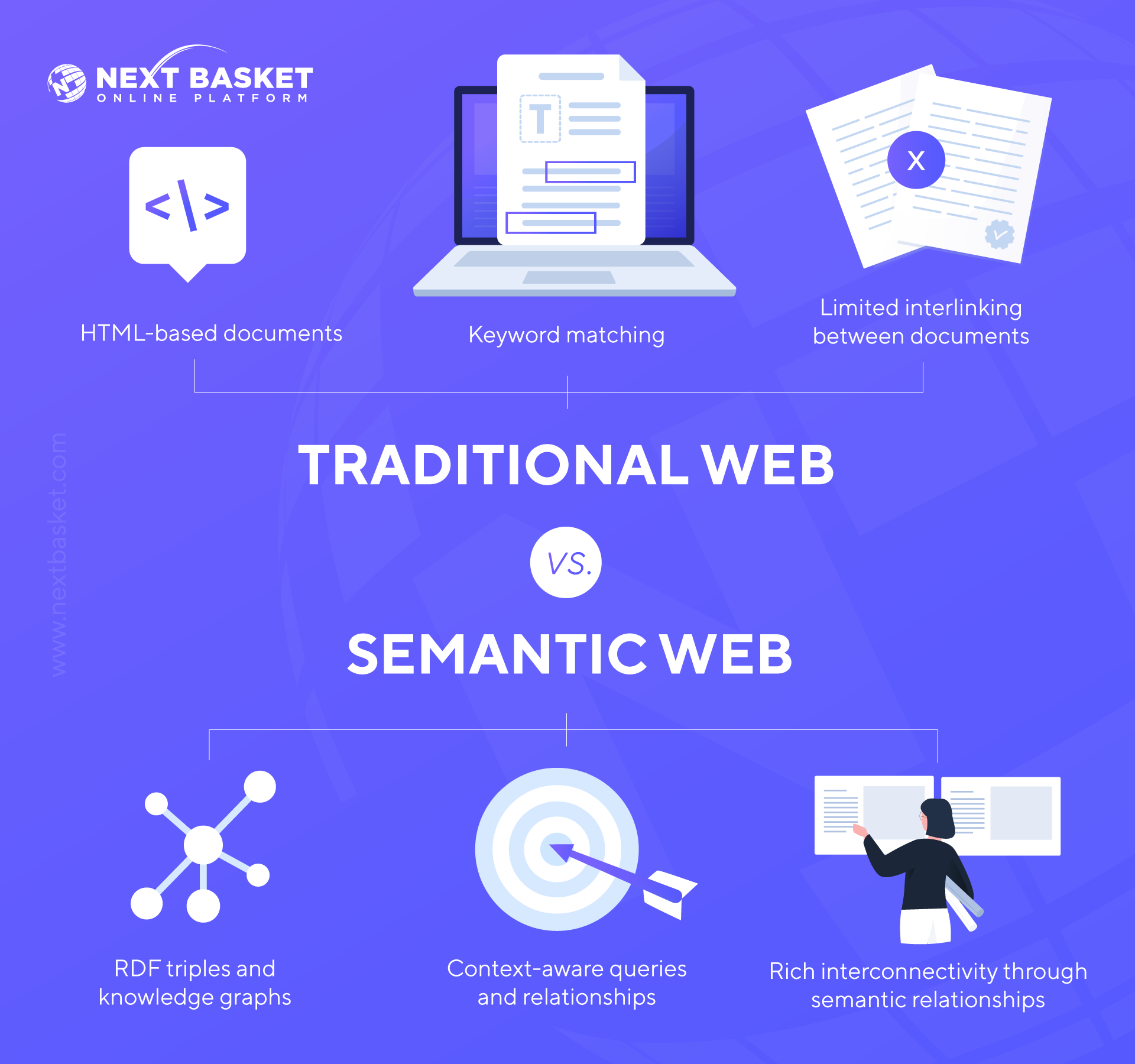Business owners looking for tech to optimize their e-commerce websites will appreciate the boost semantic web technologies bring.
But what is a semantic web? How will it help your e-commerce websites? And most importantly, how can you implement these technologies? In the next sections, you’ll learn everything you need to know about the semantic web.
Let’s get started.
Introduction to the Semantic Web: Overview and Concept
The semantic web is an incredible tool best understood in three parts: the problem, the solution, and the vision.
As it is today, the web is nothing more than a match-making machine. The current web (like websites and pages) is an extensive collection of unorganized information — a huge library without a proper catalog.
Introduced by the World Wide Web Consortium (W3C) and coined by Sir Tim Berners Lee, Semantic Web technology (also called Web 3.0, the Web of Data, or Data Web) is a concept that completely revolutionizes that idea.
In its most basic sense, the semantic web is a concept for standardizing and organizing all the data on the Internet in such a way that eliminates the guesswork and keyword matching that search engines need to do.
Search engine spiders (the artificial intelligence programs that hunt for meaning across the Internet) will understand content, context, and its various relationships. More than that, it allows us to share and reuse data across sophisticated applications, entities, and community boundaries.
At its core, the semantic web vision is to make the Internet more organized and meaningful. With this, a ranking algorithm won’t have to do the guesswork it usually does because it will understand the semantic content, its context, and its various relationships.
This innovation addresses a critical challenge online businesses face: information overload, which results in the lack of precise context in raw data interpretation. In e-commerce, businesses like yours grapple with too much data, from product descriptions to customer reviews. Semantic web is a computer science innovation that addresses this by introducing standard data formats and exchange protocols that make the day-to-day mechanisms of content more organized.
The implications are immense: it could mean enhanced discoverability, improved conversion rates, and minimized bounce rates. The Semantic Web also enables the future evolution of advanced analytics and scientific research, helping businesses to produce valuable insights from the vast amounts of data online.
Understanding Semantic Web Technologies
The Semantic Web technology stack is a complex architecture of standards and technologies, but four key technologies enable a more machine-readable format for the Internet.
These fundamental semantic technologies are RDF (Resource Description Framework), OWL (Web Ontology Language), SPARQL (SPARQL Protocol and RDF Query Language) and RIF (Rule Interchange Format).
Let’s discuss them one by one:
- RDF (Resource Description Framework): RDF is a common framework for representing information about resources (for example, in a uniform resource identifier or URI) in a graph form, using subject-predicate-object triples. It’s like saying “Author Y writes Book X” or “Webpage A is about Topic B.” This standardizes data in uniform resource identifiers, making them easier to read by search engines.
- OWL (Web Ontology Language): OWL is a language for defining ontologies, knowledge representation regarding specific domains and the relationships between entities within those domains. The OWL helps in expressing web “rules” or dictionaries that enable computers to understand specific terms. For example, they help distinguish between a “car” as a vehicle and a “car” as a railway carriage.
- SPARQL (SPARQL Protocol and RDF Query Language): SPARQL is a query language to retrieve and manipulate query data stored in RDF format. It is crucial for querying semantic data, enabling an expected evolution of developers and computer systems being able to extract specific information from RDF graphs.
- RIF (Rule Interchange Format): The RIF Production Rules Dialect or the RIF Basic Logic Dialect are both subsets of RIF – a standardized language for representing and exchanging rules and logical assertions in a machine-readable format.It allows for interchangeable rules for automated reasoning and interference.
These semantic web concepts are not just theoretical; websites are actively using them and other technologies like natural language processing (NLP) to improve data and information management.
Many websites and applications use RDF to structure their data, while OWL is used for building comprehensive ontologies. SPARQL queries are executed in various systems to extract relevant information from semantic data bases.
As these technologies mature, their practical applications continue to grow, and for all of them, alternative syntaxes exist (such as XML language), offering more and better benefits to those embracing the Semantic Web.
Semantic Web vs. Traditional Web

The Semantic Web improves the existing web by shifting from keyword-based information retrieval to a more intelligent, context-aware understanding of data.
It transforms the web from a collection of documents into a vast, interconnected knowledge graph.
Let’s look at their key differences in the table below.
| Characteristic | Traditional Web | Semantic Web |
| Data Representation | HTML-based documents | RDF triples and knowledge graphs |
| Search Mechanism | Keyword matching | Context-aware queries and relationships |
| Interconnectedness | Limited interlinking between documents | Rich interconnectivity through semantic relationships |
In the Traditional Web, information is primarily represented in HTML-based documents that describe data, and search mechanisms rely on essential keyword matching. In contrast, the Semantic Web utilizes RDF triples and graphs to express knowledge, enabling context-aware queries beyond simple keywords.
The key differentiator lies in interconnectedness. While the Traditional Web has limited interlinking between documents, relying instead on advanced guesswork through keyword matching, the Semantic Web builds rich interconnectivity through semantic relationships, allowing for a more profound and nuanced understanding of information.
Embracing the Semantic Web brings businesses like yours tons of benefits, from improved search relevance to enhanced user experiences.
Structuring Content with Semantic Markup
Now that you understand the basics of the semantic web and its principles, let’s look at specific applications of semantic web standards for your e-commerce website.
In semantic markup, applying semantic metadata is a necessary component not just for presentation but to convey the meaning and relationships of the content they surround. Unlike traditional HTML, which focuses on visual layout, semantic markup enriches the data with machine readable description, providing context to human users and search engines.
This addresses a common issue in traditional web practices where search engines struggle to interpret the true meaning of content due to the reliance on visual presentation. Semantic markup helps search engines understand the significance of content elements, leading to more accurate indexing and improved search result rankings.
For businesses, adopting semantic markup translates into enhanced search engine visibility, boosts organic traffic, and improves user experiences.

Connecting and Integrating Data Sources on the Web
Connecting and integrating data sources on the web is paramount in the digital era, especially for e-commerce businesses. The traditional web enables data silos just by existing.
Without semantic technology, it isn’t easy to create meaningful connections between data sets, which is why traditional web relies on keyword research — they guess what your customers might want based on the keywords they’re searching.
Using semantic web techniques will grant search engines the ability to establish meaningful connections between different and often disparate datasets. Many organizations use this standard to publish master data internally.
Linked Data addresses these issues by creating a web of interlinked resources, allowing businesses to integrate diverse data sources seamlessly.
For your e-commerce business, a linked data web enables a unified customer information view, enhancing your customer relationship. This, in turn, positively impacts key performance indicators (KPIs) such as customer satisfaction, repeat purchases, and overall revenue growth.
Improving Search Engine Understanding and Results
The current state of search engine understanding and results relies heavily on keyword matching, often leading to imprecise and contextually limited outcomes.
For example, when you search for best movies, the SERP shows you web pages that might contain the words best movie. You might get many reviews, news articles, and movie lists.
Using the Semantic Web, the search engine understands the keywords and the relationships and context between them. You refine your query to “top-rated action movies released in the last year.” Semantic search considers the context and relationships between words, enabling search engines to deliver more accurate and relevant results.
For businesses, this shift translates into improved visibility and discoverability. Semantic search methodologies contribute to higher search engine rankings, leading to increased organic traffic. Implementing them in your ecommerce content marketing strategy is a must.
Key Performance Indicators (KPIs) like click through and conversion rates improve as users encounter more relevant content aligned with their intent.
Knowledge Graphs: Building Rich Information Networks
The traditional web is characterized by fragmented data — like a gigantic unsorted library.
This is a big missed opportunity, as search engines can’t comprehend the relationships between different pieces of information and instead rely on guesswork to deliver relevant results.
Semantic web knowledge management proposes a shift towards knowledge graphs, where information is structured coherently. Instead of data loosely connected by keywords, knowledge graphs “connect” an idea with a web of other data and relationships. This approach to linking data is what makes the graph so powerful.
Imagine you’re searching for information about a movie. In a knowledge graph, you could start with the movie and quickly navigate to related nodes like actors, release dates, or even other movies by the same director—all seamlessly connected.
When businesses utilize knowledge graphs instead of keyword-reliant data, they enhance their understanding of customer behavior and preferences, provide more personalized recommendations, anticipate customer needs, and create a more dynamic and responsive online shopping experience.
Ontologies and Taxonomies
The current Internet is unorganized and unstructured. This is a significant challenge for e-commerce businesses, as they deal with a lot of data, and precisely defining and understanding the relationships between products, categories, and attributes makes them easier to manage and leverage for operations.
Semantic web methodologies propose a solution by introducing ontologies and taxonomies — transparent and standardized frameworks for organizing concepts and relationships. By precisely defining the semantics of terms, these systems enable e-commerce businesses to enhance the accuracy of search results, streamline inventory management processes, and create more intuitive navigation experiences for users.
Adopting ontologies and taxonomies to provide more context to terms can improve search relevance, increase conversion rates, and optimize inventory turnover rates. All these contribute to better customer satisfaction.
SEO and the Semantic Web
Businesses worldwide, even in Pakistan, rely on search engine optimization (SEO) to discover their web pages in search engine results. While SEO is an ingenious part of digital marketing in its own right, it isn’t easy to understand and rank content based on context.
While SEO is widely available, it takes a lot of time and resources to execute correctly, especially for an international website with multiple versions, and the results are not guaranteed. SEO is another semantic web application: a more organized web drastically improves SEO practices.
By incorporating structured data, semantic markup, and rich interlinking, businesses can offer search engines a deeper understanding of their content. This improves search result relevance and enhances the overall visibility of products and services.
Better-performing semantic SEO services allow businesses to improve their search engine rankings, organic traffic, click through rates, and conversion.
Making The Semantic Web Work For Your Website
You can already implement the principles of the semantic web today, and it involves using specific technologies and following standards.
Here are some tips and best practices you can apply:
- Define clear ontologies: Clearly define ontologies representing the key entities and relationships in your e-commerce domain (e.g., products, categories, specifications). This formal standardization process helps ensure a shared understanding of data elements.
- Implement schema.org markup: Utilize Schema.org markup in your HTML to provide structured data about products. This improves the visibility of your products in search engine results and enhances the chances of appearing as rich snippets, which display additional information directly in search results.
- Expose linked data for products: Assign unique URIs to each product to expose them as Linked Data. This practice facilitates integration with external datasets, enabling a more interconnected web of information and increasing the discoverability of your products.
- Enable semantic search and faceted navigation: Implement semantic search functionality using query languages like SPARQL, allowing for more complex and precise user queries. Additionally, integrate faceted navigation in your website to enable users to filter and refine search results based on various attributes such as brand, price range, and specifications.
- Implement personalized recommendations: Use semantic technologies to understand user preferences and behavior. Implement personalized recommendation systems that suggest products based on the user’s purchase history, preferences, and browsing patterns, enhancing the overall user experience.
These best practices improve the organization and accessibility of your data, enhance search capabilities, and provide personalized experiences for your customers. Talk to your IT department to implement these today.

Final Thoughts
So much has changed in the last few years that businesses in Pakistan and worldwide can have something in common — they all use the Internet. But the current web, while indeed powerful, can still be improved.
This is the vision of the Semantic Web: a more accessible, meaningful, and intelligent online world for everyone — including your e-commerce business.
And you don’t have to wait for it to happen. You can implement semantic web principles and technologies today with clear benefits.
Linked open data, better data management, improved data exchange, and robust relational databases via “machines talking” promise better e-commerce performance, which is what you need to stand out against the competition.Save this article as your reference, and embrace the semantic web today!
Frequently asked questions
How can the Semantic Web impact search engine rankings for my e-commerce website?
The Semantic Web enhances search engine understanding, leading to improved rankings. By implementing structured data, semantic HTML data tags, and rich interlinking, your e-commerce website becomes more discoverable, positively influencing SEO and increasing visibility.
Can small businesses with limited technical resources implement the Semantic Web?
Yes, some tools and resources simplify semantic web implementation. Utilize schema.org markup, adopt semantic HTML, and gradually integrate ontologies. Even small improvements positively impact search visibility and user experience.
Are any risks associated with transitioning to a Semantic Web approach for an established e-commerce website?
While the transition requires planning, the risks are minimal. Gradual implementation mitigates potential issues, starting with structured data and semantic HTML. Regular testing and monitoring ensure a smooth transition with minimal impact.